ПРИМЕНЕНИЕ КЛАССИЧЕСКИХ ИДЕЙ ОРГАНИЗАЦИОННОГО ПОВЕДЕНИЯ В ГИБКИХ ПОДХОДАХ К УПРАВЛЕНИЮ
Аннотация
В работе анализируются работы классиков управления таких как Рассел Акофф, Нэнси Адлер, Фридерик Герцберг, Крис Арджинис, Беннис Уоррен, Линдэлл Урвик, ученых из Астонской группы и других. Их связывает общее направление – организационное поведение, а также то, что их работы были написаны в прошлом веке, а еще элементы этих теорий стали основой для неоклассических теорий менеджмента, которые превалируют в настоящее время.
Цель – выявление общих признаков с итерационно-инкрементным (гибким) подходом к разработке и управлению из классических теорий управления.
Метод или методология проведения работы. В работе проведен анализ классических работы в области управления по направлению организационного поведения и теории лидерства на предмет обнаружения общих признаков с итерационно-инкрементным подходом к разработке и управлению. Эти две категории рассматриваются комплексно, поскольку лидерство может детерминировать организационное поведение. В работе применен онтологический и комплексный подходы.
Результаты. В работе определены общие признаки классических теорий и гибких подходов к управлению, это свидетельствует о том, что классические подходы к управлению легли в основу гибких подходов к управлению.
Область применения результатов. Полученные результаты применимы для ученых в области социального менеджмента, организационной психологии. Кроме того, результаты будут полезны при составлении учебных пособий и написании учебников по теории менеджмента и смежным дисциплинам. Результаты исследования вносят вклад в развитие истории управленческой мысли.
Скачивания
Литература
Список литературы
Альпидовская М.Л. Концепция рациональной бюрократии индустриального общества М. Вебера // Финансы: теория и практика. 2007. №. 2. С. 82-89.
Кнышов А.В., Царицина Ж.В. Теории X, Y и Z Дугласа Макгрегора как ключевые элементы развития системы знаний о мотивации персонала к труду // NovaUm.Ru. 2017. №. 7. С. 112-115.
Мертон, Р. Социальная теория и социальная структура / Роберт Мертон. М.: ACT: ACT Москва: Хранитель, 2006. 873 с.
Миронова Н.И. Социальная динамика: метаморфозы самоорганизации и управления. Челябинск: ОАО «Челябинский дом печати, 2005. 174 с.
Плехова О.А. Типология бюрократии в трудах М. Вебера // Экономические и гуманитарные исследования регионов. 2012. №. 2. С. 79-84.
Ackoff R.L. The circular organization: an update // Academy of Management Perspectives. 1989. Vol. 3. №. 1. P. 11-16.
Ackoff R. L. The democratic corporation: A radical prescription for recreating corporate America and rediscovering success. Oxford University Press, 1994. 272 p.
Adler N. J., Gundersen A. International dimensions of organizational behavior. Cincinnati, OH: South-Western, 2001. 398 p.
Argyris C. Inner contradictions of rigorous research. Academic Press, 1980. 203 p.
Argyris C. Overcoming organizational defenses: Facilitating organizational learning. Allyn & Bacon, 1990. 192 p.
Bennis, W. G. A theory of group development / Bennis, W. G., Shepard, H. A. // Human Relations. 1956. № 9 (40). P. 415–437.
Bennis, W. G. and Slater, P. E., The temporary society. New York: Harper & Row, 1968. 147 p.
Bennis, W.G. Managing the Dream: Leadership in the 21st Century // Journal of Organizational Change Management. 1989. Vol. 2. No 1. P. 6-10. https://doi.org/10.1108/09534818910134040
Crozier M. The Bureaucratic Phenomenon, London, 1964. 320 p.
Gulick L., and L. Urwick (Eds.). Papers on the Science of Administration. Pp. vii, 195. New York: Institute of Public Administration, 1937. 195 p.
Herzberg F. Work and the Nature of Man / 3rd Printing edition. USA: Thomas Y. Crowell Co. 203 p.
Herzberg F., Mausner B., Snyderman B.B. The Motivation to Work. USA: Transaction Publishers, 2011. 180 p.
Jaques E. A general theory of bureaucracy. London: Heinemann; New York: Halsted Press, 1976. 412 p.
Jaques E. Measurement of responsibility: A study of work, payment, and individual capacity. UK, London: Routledge, 2014. 160 p.
Jaques E. The form of time. Crane Russak, Incorporated, 1982. 238 p.
Kotter J. P. What effective general managers really do // Harvard business review. 1982. Vol. 60. №. 6. P. 156-167.
Luther Halsey Gulick, The Metropolitan Problem and American Ideas. New York: Alfred A. Knopf, 1962. 166 p.
Payne R. L., Pugh D. S. Organizational behaviour in its context: the Aston programme III. Farnborough, Hants.: Saxon House, 1977. 189 p.
Reunamäki R., Fey C. F. Remote agile: Problems, solutions, and pitfalls to avoid // Business Horizons. 2022. https://doi.org/10.1016/j.bushor.2022.10.003
Sverrisdottir H. S., Ingason H. T., Jonasson H. I. The role of the product owner in scrum-comparison between theory and practices // Procedia-Social and Behavioral Sciences. 2014. Vol. 119. P. 257-267. https://doi.org/10.1016/j.sbspro.2014.03.030
Tyagi S., Sibal R., Suri B. Empirically developed framework for building trust in distributed agile teams // Information and Software Technology. 2022. Vol. 145. P. 106828. https://doi.org/10.1016/j.infsof.2022.106828
Vickers G. The art of judgment: A study of policy making. 1965. 242 p.
References
Al’pidovskaya M.L. Finansy: teoriya i praktika, 2007, no. 2, pp. 82-89.
Knyshov A.V., Tsaritsina Zh.V. NovaUm.Ru, 2017, no. 7, pp. 112-115.
Merton, R. Sotsial’naya teoriya i sotsial’naya struktura [Social theory and social structure]. M.: ACT: ACT Moscow: Khranitel’, 2006, 873 p.
Mironova N.I. Sotsial’naya dinamika: metamorfozy samoorganizatsii i upravleniya [Social dynamics: metamorphoses of self-organization and management]. OAO Chelyabinsk Press House, 2005, 174 p.
Plekhova O.A. Ekonomicheskie i gumanitarnye issledovaniya regionov, 2012, no. 2, pp. 79-84.
Ackoff R.L. The circular organization: an update. Academy of Management Perspectives, 1989, vol. 3, no. 1, pp. 11-16.
Ackoff R. L. The democratic corporation: A radical prescription for recreating corporate America and rediscovering success. Oxford University Press, 1994, 272 p.
Adler N. J., Gundersen A. International dimensions of organizational behavior. Cincinnati, OH: South-Western, 2001, 398 p.
Argyris C. Inner contradictions of rigorous research. Academic Press, 1980, 203 p.
Argyris C. Overcoming organizational defenses: Facilitating organizational learning. Allyn & Bacon, 1990, 192 p.
Bennis, W. G. A theory of group development / Bennis, W. G., Shepard, H. A. Human Relations, 1956, no. 9 (40), pp. 415–437.
Bennis, W. G. and Slater, P. E., The temporary society. New York: Harper & Row, 1968, 147 p.
Bennis, W.G. Managing the Dream: Leadership in the 21st Century. Journal of Organizational Change Management, 1989, vol. 2, no. 1, pp. 6-10. https://doi.org/10.1108/09534818910134040
Crozier M. The Bureaucratic Phenomenon, London, 1964, 320 p.
Gulick L., and L. Urwick (Eds.). Papers on the Science of Administration. Pp. vii, 195. New York: Institute of Public Administration, 1937, 195 p.
Herzberg F. Work and the Nature of Man / 3rd Printing edition. USA: Thomas Y. Crowell Co., 203 p.
Herzberg F., Mausner B., Snyderman B.B. The Motivation to Work. USA: Transaction Publishers, 2011, 180 p.
Jaques E. A general theory of bureaucracy. London: Heinemann; New York: Halsted Press, 1976, 412 p.
Jaques E. Measurement of responsibility: A study of work, payment, and individual capacity. UK, London: Routledge, 2014, 160 p.
Jaques E. The form of time. Crane Russak, Incorporated, 1982, 238 p.
Kotter J. P. What effective general managers really do. Harvard business review, 1982, vol. 60, no. 6, pp. 156-167.
Luther Halsey Gulick, The Metropolitan Problem and American Ideas. New York: Alfred A. Knopf, 1962, 166 p.
Payne R. L., Pugh D. S. Organizational behaviour in its context: the Aston programme III. Farnborough, Hants.: Saxon House, 1977, 189 p.
Reunamäki R., Fey C. F. Remote agile: Problems, solutions, and pitfalls to avoid. Business Horizons, 2022. https://doi.org/10.1016/j.bushor.2022.10.003
Sverrisdottir H. S., Ingason H. T., Jonasson H. I. The role of the product owner in scrum-comparison between theory and practices. Procedia-Social and Behavioral Sciences, 2014, vol. 119, pp. 257-267. https://doi.org/10.1016/j.sbspro.2014.03.030
Tyagi S., Sibal R., Suri B. Empirically developed framework for building trust in distributed agile teams. Information and Software Technology, 2022, vol. 145, pp. 106828. https://doi.org/10.1016/j.infsof.2022.106828
Vickers G. The art of judgment: A study of policy making, 1965, 242 p.
Просмотров аннотации: 945
Copyright (c) 2023 Andrei V. Plotnikov, Sergei A. Elkin

Это произведение доступно по лицензии Creative Commons «Attribution-NonCommercial-NoDerivatives» («Атрибуция — Некоммерческое использование — Без производных произведений») 4.0 Всемирная.






































